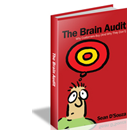When you're writing an article, inserting The Next Step should be really simple. And it is, if you are clear what you want the customer to do next. But hey, we all know what we want the customer to do next, and yet there's still a bit of doubt. Are we doing the next step right? Or not?
So here are three methods for implementing the ‘Next Step'
Method 1: Editorial Next Step
Method 2: Sales Next Step
Method 3: Embedded Next Step
Let's examine all three of them a little closely, shall we?
Method 1: Editorial Next Step
In every article your core goal is to get the reader to experience a new world. The reason the reader reads your article at all, is because you're taking them on a new journey. This journey depends on what you're covering in the article. You may be showing the reader ‘how to increase prices without losing customers'. You may be showing them how to ‘fix a roof on a garden shed'. You may be asking them to watch the video on ‘One Man, One Cow, One Planet.'
In every case, you set out to change, or at least nudge the customer into doing something. That was your goal right from the start, or you wouldn't have written the article in the first place.
So your final take on most articles would be to nudge a reader to move to the next step.
And this is what I'd brand an ‘Editorial Next Step.' In effect the editorial nudge has no sales activity in it at all. It's just saying something like:
a) Read more articles on pricing strategy.
b) Read the continuing series on how to create more durable roofs.
c) Watch the video on ‘One Man, One Cow, One Planet because it will help you understand what's happening to our soil.
The Editorial Next Step is just the push to get the person reading the article to do something. And in a way, the nudge is what the reader is expecting to get that nudge. It's a signal that the article is done. So when you look at the ‘moral of the story' in fairy tales, you notice the same nudge.
The story ends and there's a moral
That's an example of an Editorial Next Step. Which is all very fine, if all you want to do is ‘complete' an article, or get the reader to read or do something. But what if you want the reader to buy something as well? Ah, that's the ‘Sales Next Step'.
Method 2: Sales Next Step
The Sales Next Step is simply a call to action to buy something. Or do something that is more than likely to lead to sales. But how would you know if the nudge is leading to sales or editorial? Well ask yourself this: Will the customer feel a bit of resistance when they go to that next step? If so, then it's a Sales Next Step.
So if the customer has to fill in a form, opt-in, jump over some barriers, sign up, pay for something etc., then it's a Sales Next Step. The Editorial Next Step feels like friendly advice. e.g. “Hey see this movie, or you really should read this book, or go read other articles, or watch this YouTube video”.
The Sales Next Step is different, and you know there will be at least an iota of resistance when the person reads your message. And it's more than likely that your message will be ‘salesy' e.g. Sign up for this course; Sign up for the workshop, etc. Which leaves us with just one last method to the ‘Next Step': The Embedded Next Step.
c) Method 3: The Embedded Next Step
You noticed the ‘One Man, One Cow, One Planet' nudge didn't you? And you did feel curiosity when I mentioned it once. Then I mentioned it again. And then again at the start of this paragraph. Now imagine I never once told you to see the documentary, you'd still be slightly eager to check it out. And the reason was that the information was embedded as ‘editorial' content.
For instance, if I'm writing an article on Pricing Strategy, and I give examples of how we did the 5000bc.com pricing strategy, then I'm embedding a next step. When I'm writing an article in 5000bc and give you information about how we conduct The Brain Audit workshops, I'm embedding that next step into the article.
And the embedding is clearly a sales pitch? Or is it? Some people may not see the sales pitch in it at all. It may appear to be 100% editorial. And that's the beauty of the Embedded Next Step. It has no next step involved. It's not asking you to buy anything, there's not a link in sight anywhere, there's nothing. But part of, or the entire article revolves around the product or service.
Time for some examples…
a) How We Consistently Increase Prices Without Losing Customers (And this article may contain the strategy of how we've increased The Brain Audit prices from $20-$119. And how it's actually increased sales).
b) Will Customers Buy On Trust And Reputation Alone? (And this article may contain the story of our product on ‘Blackbelt Presentations' and how we generated $30,000 on the weekend, without a sales page—and on trust and reputation alone).
So as you can see, the Embedded Next Step is kinda like a case study in the article. It doesn't have to smother your article. It just has to be reasonably prominent.
Example, Example…
Let's take the example of: Will Customers Buy On Trust and Reputation Alone? In that article I can write about the concept of trust, about the concept of what causes people to trust, give them examples about the ‘Black Belt Presentations', but also give them examples of how Jack Johnson fans will buy the next album based on an announcement alone. Or how Apple will sell a new product without really having the product on the shelves yet.
We've covered a lot, so let's just summarise and then see where we can use these three ways to use the ‘Next Step'.
Summary:
1) The Editorial Next Step is to get you to do/read something.
2) The Sales Next Step has more resistance involved. And involves some sort of sales pitch, no matter how minor.
3) The Embedded Next Step has no links, no call to action, nothing. But it becomes the focus of the article. It becomes the primary case study, possibly secondary case study as well. And sure it can share the spotlight with other case studies too. But there's no call to action. That's why it's called 'embedded'.
So where do we apply these next steps?
1) The Editorial Next Step is usually placed inside the article itself. Often just after the summary. It's more than likely to be the last few sentences of the article, though it can appear before the summary from time to time—but that's rare. (You'll see an Editorial Next Step at the end of this article as well.)
2) The Sales Next Step has a clear demarcation. It sits away from the editorial, and it's clearly a sales-based nudge. Anyone looking at it should be able to tell it's a next step leading to some product/service offering. (You'll see a Sales Next Step after this article.)
3) The Embedded Next Step is embedded in your article itself. The ‘One Man, One Cow, One Planet' could have been an embedded next step, if I had any financial gain, but I don't. Besides this article is long enough, without having to bear the weight of a few cases studies as well.
So there you have it.
Three ways to get the customer to the next step. Now insert it into your articles. You can insert just the Editorial Next Step or both Editorial and Sales. Or all three.
Be clear what you want the customer to do, and they'll do it. Because you're the one who provided the next step for them to take.
Don't forget to leave your comment below
What do your customers think? What would make them buy? In the Brain Audit – Sean teaches 7 steps on how to form killer communication pieces that makes people buy from you. The Brain Audit is a simple psychological system that everyone can use in their communication to increase their profits.” Ankesh Kothari – Biztactics, USA Products: Under $50 1) Do You Often Hit A Wall Called ‘Writers Block'? 2) Do you know that visuals immediately improve your sales conversion? 3) Do your websites, brochures, presentations, etc… confuse your clients? 4) Chaos Planning 5) Nothing bugs you more than a painful client. NEW PRODUCT! Black Belt Presentations: How do you create presentations that enthrall, hold and move an audience to action? |
[next_step]


Hello Sean. I thoroughly enjoy your articles and want to thank you for being so generous with your information and ideas, and making me chuckle so often.At the moment I have no time for study so the articles are perfect. I learn from them on the fly, and use the info to write my own articles etc. I have bought one of your books and used some of the ideas to rewrite text in my website. It took me awhile to develop some understanding about what you were saying because it was like learning a foreign way of thinking. I still prefer to teach rather than sell I’ve noticed, and I do realise that there are distinct similarities between the two. I hope all is well with you and yours anyway. I hope to continue getting these articles for some time to come!
Warmly,
Anne
Thanks Anne.
Great post, i’m trying to expand my subscriber base and these tips will be of use.
Nice article with very practical tips for getting the work done. I’m printing it out to read over several more times.
The most important is the embedded concept. We use it everywhere. In our books, presentations—everywhere. Listen to the audio as well, as it goes into a bit more detail (The audio is above, but you can also get it on iTunes as a download).
Thanks for this great post. Have been properly ‘nudged’ in the right direction!